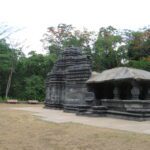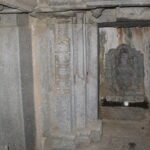
Tambdi Surla Temple Also known as: Mahadev Temple, is a Hidden amidst the dense forests of the Western Ghats and cradled within the Bhagwan Mahaveer Wildlife Sanctuary, the Tambdi Surla Temple stands as a timeless tribute to Goa’s ancient Hindu heritage. Recognized as the oldest surviving Hindu temple in the state, it dates back to the 12th century CE, during the reign of the Kadamba dynasty, who were staunch patrons of Shaivism.
This sacred shrine is dedicated to Lord Shiva, one of the principal deities of the Hindu pantheon, revered as the destroyer and transformer. What sets Tambdi Surla apart from other temples in Goa is not just its age, but also its unique architectural style and remote, untouched setting—a stark contrast to the Portuguese-style churches that dominate much of Goa’s religious landscape.
History of Tambdi Surla Temple
The Tambdi Surla Temple, dedicated to Lord Shiva, is an enduring relic of Goa’s pre-Portuguese Hindu era, dating back to the 12th century CE. It was built during the reign of the Kadamba dynasty, a powerful ruling family who governed parts of Karnataka and Goa between the 10th and 14th centuries. The Kadambas were known for their patronage of Shaivism and temple architecture, and this temple remains a glowing testament to their cultural and religious contributions.
1. Era of Construction
The temple was most likely constructed around 1166 CE, during the reign of King Jayakeshi II of the Kadamba dynasty. This period witnessed the flourishing of regional temple styles, blending influences from Chalukya and Yadava architectural forms. While the Kadambas ruled from their capital at Chandor and later at Gopakapattana (modern-day Goa Velha), they established many temples, but most were later destroyed or modified under foreign rule.
Tambdi Surla is one of the few temples that survived this turbulent history, primarily due to its remote and forested location. Unlike other Kadamba-era temples, which were often razed during the Islamic invasions or the Portuguese colonization, this temple escaped notice and destruction.
2. Portuguese Colonial Period (1510 Onwards)
When the Portuguese arrived in Goa in the early 16th century, they began a widespread campaign of Christianization, which involved demolishing or converting Hindu temples and restricting local religious practices. However, Tambdi Surla remained untouched, most likely because:
It was located deep within the Western Ghats, far from the urban centers of Portuguese control.
The dense forest cover and hilly terrain made it difficult to access and monitor.
As a result, Tambdi Surla is one of the few intact pre-Portuguese Hindu temples in Goa.
3. Religious Significance Over Time
Despite political changes in Goa’s history, devotion at Tambdi Surla Temple never ceased. The temple has remained an active site of Shaivite worship for centuries, with daily rituals still performed by local priests. Its most important festival is Mahashivaratri, during which thousands of devotees visit the shrine to offer prayers, perform abhishekas (ritual bathing of the Shiva Linga), and celebrate with traditional music and dance.
4. Modern Recognition & Conservation
In the post-independence era, the Archaeological Survey of India (ASI) took over the protection and conservation of the temple. It is now recognized as a monument of national importance, and its architectural integrity and historical significance are preserved and promoted by the ASI.
Tambdi Surla has since gained attention from historians, archaeologists, and cultural travelers, not just for its spiritual value but also as a window into Goa’s lesser-known indigenous temple architecture, predating colonial influences.
Architecture of Tambdi Surla Temple
The Tambdi Surla Temple is an outstanding example of Kadamba-Yadava architectural style, showcasing exceptional craftsmanship in stone carving and temple planning. Built entirely out of black basalt stone, this 12th-century temple is not only unique for its materials and style but also for its compact, elegant proportions and intricate sculptural details that have withstood the test of time.
Structure and Layout
The temple follows a traditional Shaivite layout, comprising three key parts:
1. Garbhagriha (Sanctum Sanctorum)
- The innermost chamber of the temple, housing a beautifully polished Shiva Linga, the symbolic representation of Lord Shiva.
- The sanctum is simple but sacred, and devotees circumambulate it as part of their worship ritual.
2. Antarala (Vestibule or Antechamber)
- A small chamber that connects the sanctum with the outer hall.
- Acts as a transitional space, possibly used for priests to prepare for rituals.
3. Mandapa (Pillared Hall)
- The mandapa or prayer hall is open on three sides and features four richly carved pillars that support the ceiling.
- The pillars and ceiling beams are adorned with exquisite carvings of mythological scenes, floral patterns, deities, and motifs from epics like the Ramayana and Mahabharata.
4. Nandi Mandapa
- Facing the sanctum is a stone image of Nandi, the sacred bull and vehicle (vahana) of Lord Shiva.
- Nandi is placed in a small, roofless pavilion aligned perfectly with the Shiva Linga inside the sanctum, maintaining ritual axial symmetry.
5. Material and Carving Style
- The entire temple is carved out of fine-grained basalt, believed to have been transported from the Deccan plateau.
- The stones were joined without mortar, using precision-cut interlocking methods—a testament to the advanced craftsmanship of the time.
- Despite being over 800 years old, many of the sculptural details are still sharp and intact, including miniature friezes and deity carvings.
6. Shikhara (Superstructure)
- The original shikhara (tower above the sanctum) is partially broken today, but remnants suggest it was once stepped and crowned with ornate finials.
- Its design is typical of the Kadamba style, which was modest in height but rich in detail, unlike the soaring towers seen in later temple styles like Hoysala or Dravidian architecture.
7.Setting and Orientation
- The temple is oriented towards the east, allowing the rising sun’s rays to illuminate the Shiva Linga in the morning—a common Vastu practice in Hindu temple architecture.
- It is surrounded by forested hills, adding a serene natural backdrop that enhances the spiritual and aesthetic appeal of the temple.
Images of Tambdi Surla Temple



Scenic Location
- Set in the dense Bhagwan Mahaveer Wildlife Sanctuary, surrounded by forests, streams, and hills.
- Close to Tambdi Surla Waterfall, a 90-minute trek from the temple.
- Great for nature lovers, birdwatchers, and trekkers.
Best Time to Visit
- October to March – Pleasant weather for both spiritual visits and nature walks.
- Avoid during peak monsoon due to slippery trails and heavy rains.
How to Reach Tambdi Surla Temple
- Nearest City: Ponda (approx. 22 km) or Panaji (approx. 65 km)
- By Road:
- Accessible by car, taxi, or bike. The roads are narrow but scenic.
- Public Transport: Limited. It’s advisable to use private or hired vehicles.
Nearby Attractions of Tambdi Surla Temple
1. Tambdi Surla Waterfall
Distance: ~1.5 km (approx. 90-minute trek)
Highlights:
- A scenic and moderately challenging forest trek leads you to this hidden gem of a waterfall.
- Surrounded by thick jungle, moss-covered boulders, and bird calls.
Tip: Best visited post-monsoon (October–December); wear trekking shoes and carry water.
2. Bhagwan Mahaveer Wildlife Sanctuary & Mollem National Park
Distance: The temple lies within this sanctuary
Highlights:
- Goa’s largest wildlife sanctuary, spread across 240 sq. km.
- Home to animals like leopards, deer, gaurs (Indian bison), Malabar giant squirrels, and many species of birds and butterflies.
- You can also enjoy nature trails, birdwatching, and guided forest treks.
Entry Fees: Applicable; available at the forest department counter.
3. Dudhsagar Waterfalls
Distance: ~22 km from Tambdi Surla
Highlights:
- One of India’s tallest waterfalls (approx. 310 meters).
- Named “Dudhsagar” or “Sea of Milk” because of its frothy white water.
- You can reach it by jeep safari (from Castle Rock or Collem) or train (passing over the famous Dudhsagar Railway Bridge).
Best time: During or just after monsoon (July to October)
4. Surla Village
Distance: ~2 km
Highlights:
- A quiet Goan village near the temple.
- Offers a glimpse into local culture, traditional homes, and village life.
- Good spot for short walks and casual photography.
5. Devil’s Canyon (Devcharacho Kond)
Distance: ~18 km
Highlights:
- A mysterious and powerful gorge carved by the Mandovi River.
- Known for its treacherous currents and eerie silence.
- Offers dramatic photo opportunities and dense greenery.
Note: No swimming allowed—very dangerous due to underwater whirlpools.
6. Castle Rock (Karnataka border)
Distance: ~25–30 km (border of Goa-Karnataka)
Highlights:
- A quaint hill station on the Goa–Karnataka railway route.
- Popular with trekkers and birdwatchers.
- Starting point for treks to Dudhsagar Falls.
7. Kulem (Collem)
Distance: ~13 km
Highlights:
- Nearest railway station to Tambdi Surla and gateway to the wildlife sanctuary.
- Base village for Dudhsagar waterfall jeep safaris and jungle treks.
- Has forest guest houses and eco-tourism facilities.
Travel Tips
- Wear comfortable shoes if you plan to trek to the waterfall.
- Carry water and snacks—there are limited facilities near the temple.
- Photography is allowed, but respect the sanctity of the temple.
- Dress modestly as it is a functioning religious site.
- Be cautious of monkeys and avoid feeding wildlife.

